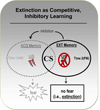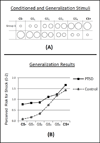Learning models of PTSD: Theoretical accounts and psychobiological evidence
- PMID: 25462219
- PMCID: PMC4809259
- DOI: 10.1016/j.ijpsycho.2014.11.006
Learning models of PTSD: Theoretical accounts and psychobiological evidence
Abstract
Learning abnormalities have long been centrally implicated in posttraumatic psychopathology. Indeed, of all anxiety disorders, PTSD may be most clearly attributable to discrete, aversive learning events. In PTSD, such learning is acquired during the traumatic encounter and is expressed as both conditioned fear to stimuli associated with the event and more general over-reactivity-or failure to adapt-to intense, novel, or fear-related stimuli. The relatively straightforward link between PTSD and these basic, evolutionarily old, learning processes of conditioning, sensitization, and habituation affords models of PTSD comprised of fundamental, experimentally tractable mechanisms of learning that have been well characterized across a variety of mammalian species including humans. Though such learning mechanisms have featured prominently in explanatory models of psychological maladjustment to trauma for at least 90years, much of the empirical testing of these models has occurred only in the past two decades. The current review delineates the variety of theories forming this longstanding tradition of learning-based models of PTSD, details empirical evidence for such models, attempts an integrative account of results from this literature, and specifies limitations of, and future directions for, studies testing learning models of PTSD.
Keywords: Extinction; Fear-conditioning; Habituation; Overgeneralization; PTSD; Sensitization.
Copyright © 2014 Elsevier B.V. All rights reserved.
Figures



References
-
- Adamec RE, Morgan HD. The effect of kindling of different nuclei in the left and right amygdala on anxiety in the rat. Physiology and Behavior. 1994;55:1–12. - PubMed
-
- American Psychiatric Association. Diagnostic and statistical manual of mental disorders. 5th. Arlington, VA: American Psychiatric Publishing; 2013.
-
- Armony JL, Servan-Schreiber D, Romanski LM, Cohen JD, LeDoux JE. Stimulus generalization of fear responses: Effects of auditory cortex lesions in a computational model and in rats. Cerebral Cortex. 1997;7:157–165. - PubMed
-
- Blechert J, Michael T, Vriends N, Margraf J, Wilhelm FH. Fear conditioning in posttraumatic stress disorder: Evidence for delayed extinction of autonomic, experiential, and behavioural responses. Behaviour Research and Therapy. 2007;45:2019–2033. - PubMed
Publication types
MeSH terms
Grants and funding
LinkOut - more resources
Full Text Sources
Other Literature Sources
Medical
Miscellaneous

